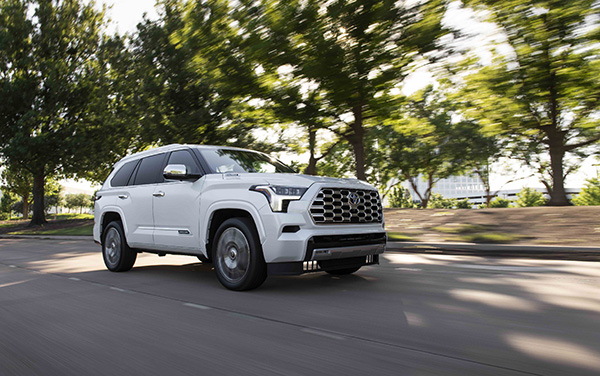The Toyota Sequoia, being a big SUV, has always come standard with a big V8. The just-redesigned Sequoia no longer offers one, but it offers some other things instead, including more power, more towing capability and much better gas mileage.
That’s part of Toyota’s replacement for displacement.
The Sequoia is Toyota’s full-size (three-row) SUV. Like the others in its class — including the Chevy Tahoe and Ford Expedition — it is based on a full-size truck (the Tundra, in this case) and shares the same basic drivetrain and underlying chassis.
Like the Expedition, which also used to come standard with a V8, the Sequoia comes standard with a turbocharged V6. Unlike the Expedition, the Sequoia’s V6 is efficiently augmented by a mild hybrid system that enables it to use less gas than the Expedition does, while delivering much more standard power (437 horsepower vs. 380 horsepower for the Expedition’s standard engine. A 400-horsepower version is available, but you must buy the more expensive trims to get it).
Prices start at $59,865 for the base trim 2-wheel-drive SR5. Adding 4WD — real 4WD, with a two-speed transfer case and 4WD low-range gearing — bumps the price up to $62,865.
There are also Limited ($66,265), Platinum ($72,465), Capstone ($76,865) and TRD Pro ($77,565) trims. The TRD pro comes standard with 4WD and a plethora of additional equipment, including a locking differential, 18-inch wheels with knobby tires, Fox coil-over shocks with remote oil reservoirs, skid plates and more suspension articulation for additional off-road capability.
What’s new for 2023: The ’23 Sequoia is all-new from the floor pans up.
What’s good: Stronger, more fuel-efficient standard engine than rivals’ optional engines; V6 sounds like a V8; does not force you to tap/swipe to operate most accessories.
What’s not so good: Base price is thousands higher than that of rivals like the Expedition and Tahoe; less total cargo space than others in the class; V6 isn’t a V8.
Under the hood: You may already know that the Tundra, Toyota’s full-size pickup truck, no longer comes standard with or even offers a V8 engine. Accordingly, neither does the new Sequoia, which is closely related to it.
Typically, you get less power and capability from a smaller engine by dint of the fact that they are … smaller. Turbocharging them makes them temporarily bigger when you need more power than they otherwise make. And when you don’t need full power, they use (and “emit”) less gas.
Toyota has taken this one step further by adding a hybrid side to the mix. The new Sequoia’s 3.5-liter V6 thus has the added advantage of not having to make any power at all whenever conditions are such that it’s not needed, as when decelerating, coasting and “idling.”
The end result is hard to critique: 437 total horsepower (vs. 381, previously, from the old Sequoia’s 5.7-liter V8) and 583 foot-pounds of torque, all of the latter on tap at just 2,400 rpm. And a standard 9,500-pound towing capacity.
The Sequoia’s V6 is much less thirsty, too. How about 21 miles per gallon city, 24 mpg highway vs. the previous 13 mpg and 17 mpg?
On the road: The only way to tell there isn’t a V8 under the hood of the new Sequoia is to pop the hood and have a look. You certainly cannot tell by ear. The sound coming from there is authentically V8 — sans the V8 under there. Toyota has perhaps the best sound-augmentation technology currently available. Drive this rig and hear it for yourself.
Also, feel it. With nearly 600 foot-pounds of torque on tap at a fast idle, the Sequoia lunges forward — when asked to — like a ’60s muscle car powered by a big-block V8. And few of those produced as much torque as this V6 does.
Combine the sound and the fury and it is easy to not miss having a V8.
At the curb: As big (and wide) as it is, the Sequoia — at 208.1 inches long — is slightly shorter than the Expedition (210 inches) and the Tahoe (210.7 inches), but it manages to offer split-the-difference room for cargo behind its third row — 22.5 cubic feet vs. 20.9 cubic feet for the Expedition and 25.5 cubic feet for the Tahoe.
The Tahoe and Expedition do have more total cargo area, however — 122 cubic feet and 104.6 cubic feet, respectively, vs. 86.9 cubic feet in the Sequoia.
The rear liftgate is also minivan-huge; when open, the entirety of the space within is opened up. Toyota also includes a few small but thoughtful items such as a swath of carpet with Velcro tabs you can use to easily secure grocery bags from moving around once you’re rolling.
SR5s come standard with a smaller (8-inch) touch screen; Limited and higher trims get a larger (14-inch) unit. But, again, neither unit requires you to tap and swipe to make everyday adjustments such as increasing or decreasing the volume of the radio, which you can turn up or down by rotating a simple, functionally effective knob. Ditto the gear selector, which isn’t a knob. It’s a lever that you pull back and forward to get the gear you want. Or Park. It’s much more instinctively, intuitively usable than a rotary knob (or buttons).
The rest: If you’d like even more sound to go with the fury, you can also specify a more aggressive-sounding TRD exhaust system as a factory or dealer-installed option.
The bottom line: It’s sad to see V8s being forced off the market. But it’s happy to find out that Toyota’s found a way to help you not miss them.



